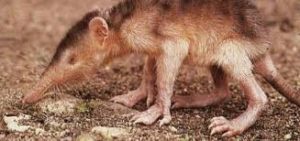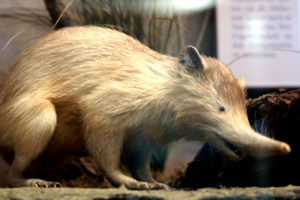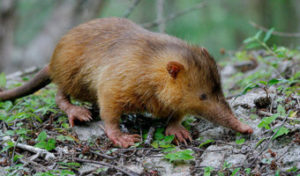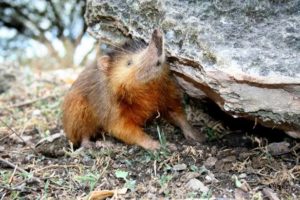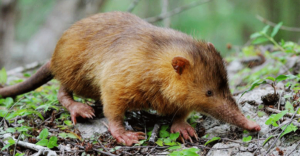 EL ALMIQUÍ, EL ÚNICO MAMIFERO CUBANO QUE CONOCIÓ A LOS DINOSAURIOS.
EL ALMIQUÍ, EL ÚNICO MAMIFERO CUBANO QUE CONOCIÓ A LOS DINOSAURIOS.
El Almiquí cubano, también conocido como Solenodonte, único animal mamífero viviente que únicamente habita en Cuba, en la República Dominicana y Haití, en el Caribe es considerado un fósil viviente ya que evolucionó hace aproximadamente 78 millones de años, y sus parientes más cercanos son los topos y las musarañas.
Solo han sobrevivido dos especies bastante parecidas: el almiquí de Cuba (Solenodon cubanus) y el almiquí paradójico (Solenodon paradoxus), en La Española.
El Solenodonte debería ser famoso porque de alguna manera sobrevivió a la colisión de un asteroide que acabó con los dinosaurios, por no hablar de los 66 millones de años de otras catástrofes, desde las edades de hielo a la llegada del destructor bípedo llamado Homo Sapiens, afirma el diario ingles The Guardian.
Los investigadores no están completamente seguros de donde se encontraban las distintas poblaciones de Solenodonte cuando el asteroide golpeó a la Tierra – probablemente ya estaban en las masas de tierra que se convertirían en Cuba y La Española o en el continente – pero piensan que las poblaciones estaban cerca de la zona cero del impacto del asteroide, en Chicxulub, México.
“Es verdaderamente notable que los solenodontes sobrevivieron a este golpe directo, mientras que los ecosistemas globales se desplomaron y no tenemos idea de cómo lo lograron”, dijo Samuel Turvey, un experto en la materia e investigador principal de la Sociedad Zoológica de Londres (ZSL).
“El linaje del Solenodonte proviene de otros mamíferos que vivieron hace aproximadamente 78 millones de años. Eso significa [que] ha existido desde el período Cretácico “, dijo Adam Brandt, autor principal de un estudio reciente que develó el ADN mitocondrial del Solenodonte.
Realmente no hay nada similar en el planeta al solenodonte. Hay sólo dos especies que sobreviven hoy en día, que se encuentran en Cuba -el almiquí y la jutía- y el otro, más conocido, en La Española. Pero estas dos especies por sí solos son tan distintas de cualquier otro mamífero que representan una familia biológica entera: Solenodontidae. Para poner esto en perspectiva tenga en cuenta que todas las especies de ratones y ratas – desde el ratón enano africano a la phloeomys pallidus – también representan una única familia, que tiene más de 700 especies.
Estos mamíferos nocturnos viven en madrigueras y salen por la noche a comer los gusanos e insectos, probablemente, tal como lo hicieron hace 78 millones de años, sólo que ahora no tienen que preocuparse de ser pisado por un saurópodo o despertar por la falta de sueño de un tiranosaurio. En su lugar, estas especies tienen que preocuparse por amanecer en bosques talados por personas o ser comido por un perro o una mangosta.
Norvis Hernández, un biólogo cubano, es una de las pocas personas en el planeta Tierra que ha visto al Solenodonte cubano. Más pequeño que su primo de La Española, el almiquí se distingue fácilmente por su cabello blanco y negro.
“Esta experiencia de ver esta antigua especie [fue] maravillosa” dijo Hernández, quien atrapó un ejemplar de almiquí hembra en el Parque Nacional Alejandro de Humboldt, en el Oriente de Cuba, para un breve estudio antes de soltarlo de nuevo. “No puedo explicar lo que sentí la primera vez que lo toqué.”
El almiquí fue descrito por primera vez en 1861 y nadie había visto uno durante casi cien años – y muchos asumieron que se había extinguido – hasta que los investigadores detectaron unos pocos en la década de 1970. Desde entonces nadie lo vio de nuevo hasta el año 2003. Hoy los científicos han confirmado que hay una pequeña población en el Parque Nacional Alejandro de Humboldt. Pero nadie sabe cuántos o si su área de distribución se extiende más allá de los límites del parque.
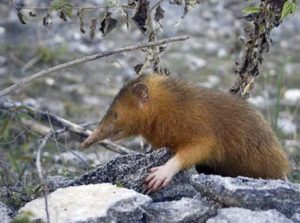 EL ALMIQUÍ, THE ONLY CUBAN MAMMAL ANIMAL WHO KNEW THE DINOSAURS.
EL ALMIQUÍ, THE ONLY CUBAN MAMMAL ANIMAL WHO KNEW THE DINOSAURS.
The Cuban Almiquí, also known as Solenodonte, the only living mammal animal that only inhabits Cuba, the Dominican Republic, and Haiti, is considered a living fossil in the Caribbean since it evolved approximately 78 million years ago, and its closest relatives are moles and shrews.
Only two quite similar species have survived: the Cuban almiquí (Solenodon cubanus) and the paradoxical almiquí (Solenodon paradoxus), in Hispaniola.
The Solenodon should be famous because it somehow survived an asteroid collision that wiped out the dinosaurs, not to mention the 66 million-year-old another catastrophe, from the ice ages to the arrival of the biped destroyer named Homo Sapiens, affirms the English newspaper The Guardian.
The researchers are not entirely sure where the various populations of Solenodon were when the asteroid hit Earth – they were probably already in the landmasses that would become Cuba and Hispaniola or the mainland – but they think the populations were near the ground zero of the asteroid impact, in Chicxulub, Mexico.
“It is truly remarkable that the solenodons survived this direct hit, while global ecosystems collapsed and we have no idea how they did it,” said Samuel Turvey, a subject matter expert and principal investigator for the Zoological Society of London (ZSL ).
“The Solenodon lineage comes from other mammals that lived approximately 78 million years ago. That means [that] it has been around since the Cretaceous period, “said Adam Brandt, lead author of a recent study that uncovered the mitochondrial DNA of Solenodon.
There really is nothing similar on the planet to the solenodon. There are only two species that survive today, found in Cuba – the almiquí and the jutía – and the other, better known, in Hispaniola. But these two species alone are so different from any other mammal that they represent an entire biological family: Solenodontidae. To put this in perspective, keep in mind that all species of mice and rats – from African dwarf mice to phloeomys pallidus – also represent a single family, which has more than 700 species.
These nocturnal mammals live in burrows and go out at night to eat worms and insects, probably just as they did 78 million years ago, only now they don’t have to worry about being stepped on by a sauropod or waking up from lack of sleep. of a tyrannosaurus. Instead, these species have to worry about dawn in forests cut by people or eaten by a dog or mongoose.
Norvis Hernández, a Cuban biologist, is one of the few people on planet Earth who has seen the Cuban Solenodon. Smaller than its Spanish cousin, the almiquí is easily distinguished by its black and white hair.
“This experience of seeing this ancient species [was] wonderful,” said Hernández, who caught a female almiquin specimen in Alejandro de Humboldt National Park in eastern Cuba for a brief study before releasing it again. “I can’t explain what I felt the first time I touched it.”
The almiquí was first described in 1861 and no one had seen one for nearly a hundred years – and many assumed it was extinct – until researchers spotted a few in the 1970s. Since then, no one saw it again until the year 2003. Today scientists have confirmed that there is a small population in the Alejandro de Humboldt National Park. But no one knows how many or if its range extends beyond the park’s boundaries.
Agencies/ The Guardian/ Portalcuba/ Internet Photos/ Arnoldo Varona/ www.TheCubanHistory.com
THE CUBAN HISTORY, HOLLYWOOD.



